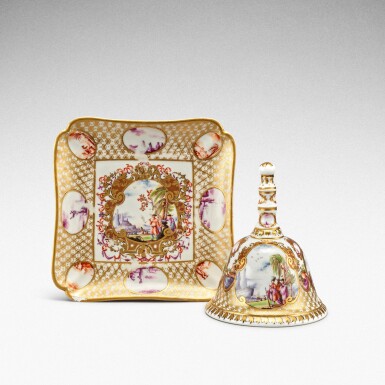
A rare Meissen table bell and stand, Circa 1730-35
Auction Closed
September 14, 05:54 PM GMT
Estimate
20,000 - 30,000 USD
Lot Details
Description
A rare Meissen table bell and stand, Circa 1730-35
the domed bell painted on the front and reverse with Chinoiserie harbour scenes within Böttger lustre and gilt scrollwork-edged cartouches, the sides with oval panels of figures in landscapes within Böttger lustre and gilt borders incorporating small purpurmalerei panels, affixed with an upright moulded handle with similarly edged iron-red or purpurmalerei figural panels, the exterior and interior of the rim with gilt trelliswork borders reserved with further small panels, the centre of the stand painted with figures in a landscape within an elaborate Böttger lustre, iron-red, purple and gilt scrollwork-edged cartouche, the rim with a wide gilt trelliswork border reserved with oval figural panels iron-red or purpurmalerei, the underside of the stand painted with four trailing branches of indianische Blumen, the stand with caduceus mark in underglaze-blue.
Height of bell: 5⅛ in., Width of stand: 6 in.
13 cm., 15.3 cm.
Hoth Collection, Berlin, sale, Rudolph Lepke's Kunst-Auctions-Haus, Berlin, February 23-24, 1926, lot 117, pl. 4;
Margarethe (née Knapp, 1878-1949) and Dr. Franz (1871-1950) Oppenheimer, Berlin & Vienna, bearing label (by 1927) (no. 212 in black);
Dr. Fritz Mannheimer (1890-1939), Amsterdam & Paris, inv. no. Por. 369 (acquired between 1936 and 1939);
Dienststelle Mühlmann, The Hague (acquired from the Estate of the above in 1941 on behalf of the Sonderauftrag Linz for the proposed Führermuseum);
On deposit at Kloster Stift Hohenfurth;
On deposit at Salzbergwerk Bad Aussee;
Recovered from the above by Allied Monuments Officers and transferred to the Central Collecting Point Munich (MCCP inv. 1620/13 a/b);
Repatriated from the above to Holland between 1945 and 1949;
Loaned by the Dutch state to the Kunstmuseum Den Haag by 1953;
Restituted by the above to the heirs of Margarethe and Franz Oppenheimer in 2021
Ludwig Schnorr von Carolsfeld, Sammlung Margarete und Franz Oppenheimer. Meissener Porzellan, Berlin, 1927, no. 212, pl. 96
The rare survivals of this fragile form include a bell and stand, painted with Chinoiserie figures, formerly in the collections of Dr. Fritz Clemm, Berlin; and Dr. Ludwig Darmstädter, Berlin, which subsequently entered the collection of Dr. Fritz Mannheimer and is now in the Rijksmuseum, illustrated in den Blaauwen, 2000, p. 94, Inv. BK-17414-A/B; A bell painted with harbour scenes is in the Pauls-Eisenbeiss Collection, Basel, illustrated in Dr Erika Pauls-Eisenbeiss, 1972, Vol. I, pp. 464-65; A bell, part of a desk set with an inkwell, pounce pot and a rectangular tray dated 1735 and painted with harbour scenes, was included in group of porcelains delivered to Christian VI of Denmark and his consort Queen Sophie Magdalene, now in the Museums für Kunst und Gewerbe, Hamburg, illustrated in Jørgen Hein and 'Mogens Bencard, Denmark and Saxony, Family Ties and Meissen Porcelain' in Cassidy-Geiger, 2007, p. 184, fig. 8-18. A bell stand of this form, also bearing a caduceus mark was in the Maurice de Rothschild Collection, sold, his (anon.) sale, Christie's London, March 28, 1977, lot 20, alongside an associated bell, lot 19.
You May Also Like


